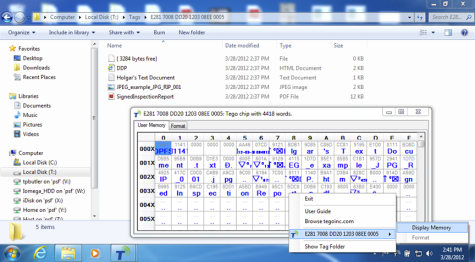RFID Software Debuts Using a Simple Drag-and-Drop Interface
 While radio frequency identification (RFID) solutions for industry have not yet reached the maturity level of say, bar codes, it's clear that hardware innovation has led that of software. But the programmers may yet be catching up as evidenced by a new product unveiled last month at the RFID Journal LIVE trade show in Orlando, Florida.
While radio frequency identification (RFID) solutions for industry have not yet reached the maturity level of say, bar codes, it's clear that hardware innovation has led that of software. But the programmers may yet be catching up as evidenced by a new product unveiled last month at the RFID Journal LIVE trade show in Orlando, Florida.
Massachusetts-based Tego, Inc, a leader in extended memory RFID solutions for creating smart assets, presented TegoDrive as a simple way to add and modify content on an RFID tag. The software runs either on a handheld RFID reader or a computer desktop connected to a fixed reader.
Historically, accessing RFID assets required the creation and customization of proprietary RFID reader applications that could talk to existing enterprise software. And since different industries had divergent needs, each wanted a customized solution.
But TegoDrive Software turns a desktop computer running Microsoft Windows into a powerful RFID reader application, where RFID assets can be accessed and modified using the familiar drag-and-drop process with a mouse. And since the operating system and the commands needed to use it are already familiar for most people in the business world, the learning curve is that much flatter.
"Seeing TegoDrive for the first time, our users were amazed by its simplicity," said Dennis Khoo, the CEO of Xerafy. "Now, TegoDrive makes it easy for customers to write data directly to our high-memory XL tags without requiring special programs or data formatting for tag encoding."
A software solution compatible with both low and high-memory RFID tags, Tego points to the aviation and shipping industries as places where the RFID software can quickly make a difference.
Every aircraft part must carry a specific FAA form, yet there's no common format for including the document on RFID tags. With the RFID software, the completed form can be quickly and easily added to the tag, using a variety of formats (pdf, jpg, htm, or txt file) and universally accessed as needed.
Many supply chains commonly use the Advanced Shipping Notice (ASN) as a packing list or manifest for shipping containers and cargo pallets. Adding this form to RFID tags will allow for easy inspection during transport without the need for specialized RFID reader software.
Currently in beta testing by customers in multiple industries, the software combined with a third-party RFID reader and RFID tags launched in kit form for less than $1,000. The company also plans to offer a stand-alone version of the software at a pricing level comparable to many office applications.
See related articles:
RFID Tags Designed to Reduce Truancy and Improve Safety in Schools
How Chip-based Serialization Benefits Item Level RFID
RFID Tracking Helps Pinpoint Final Resting Places With Ease
{jcomments on}
